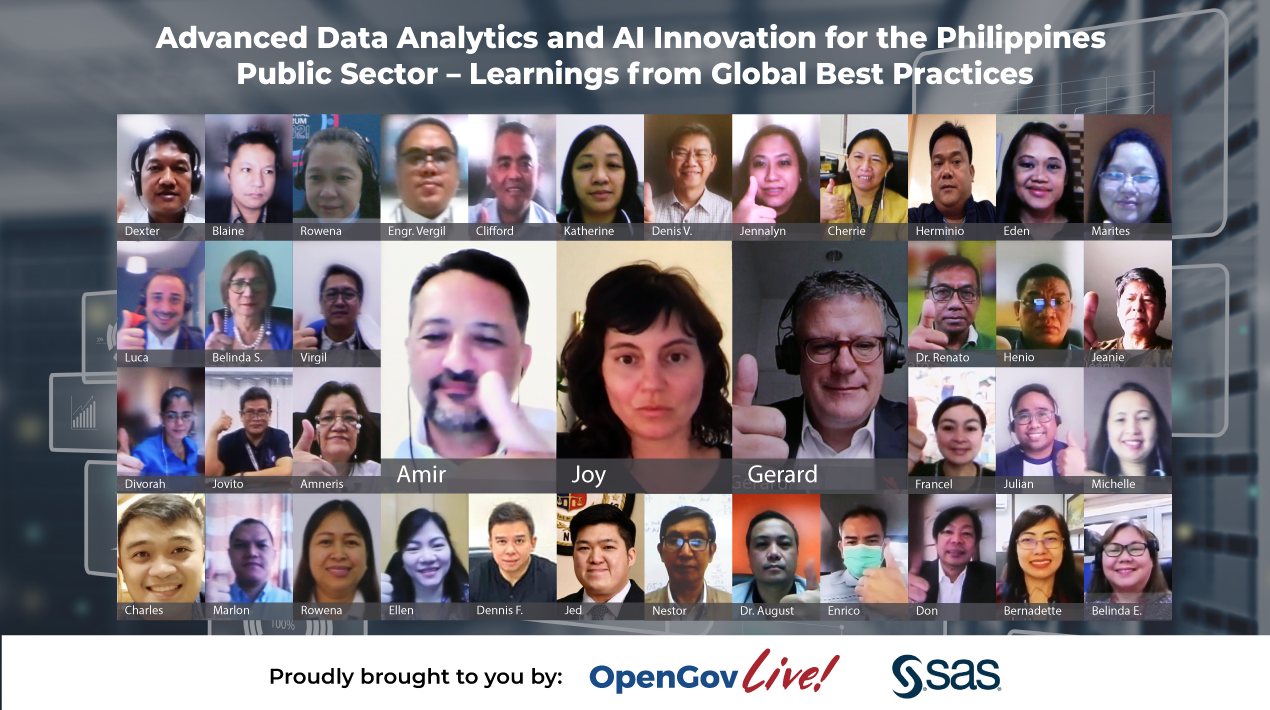
Data and Artificial Intelligence (AI) have the potential to have a huge transformative impact on the public sector, given governments’ access to massive amounts of data and their operations affect the citizens.
A progressive, safe, secure, comfortable and happy country is what the Philippine public sector seeks to achieve through innovation and ongoing ICT growth. By better harnessing the power of data through a robust data and AI strategy, the government can accomplish its goals and mandates.
It is globally acknowledged that the huge amounts of digital data created by citizens’ actions are a very valuable resource. However, this constantly growing data resource is not being used to its full potential currently. Agencies have a hard time getting the most out of their data because their systems are old and their analytics skills are limited. They have a lot of data but not much insight.
Data will become an even more valuable commodity as the Philippines accelerates its digital transformation efforts to have a “One Digitised Government.”
Learnings from global best practices for advanced data analytics and AI in the Philippines was the focus of the OpenGovLive! Virtual Breakfast Insight on 14 July 2022 for senior digital executives from the Philippine public sector.
Developing a Data-Driven Public Sector: The Road Ahead

To kickstart the session, Mohit Sagar, CEO and Editor-in-Chief, OpenGov Asia, delivered the opening address. He believes that many people struggle with the associated, but unnecessary, challenges of big data, such as high costs, poor data quality and inconsistent data sources and formats, without reaping any of the enticing benefits.
“Public sector agencies require a multifaceted approach, including the ability to quickly integrate new data, make accurate, multilevel forecasts and provide data-driven insights for policymakers,” claims Mohit.
Agencies are expected to make decisions based on what is best for individuals, families and communities. Following this imperative, leaders in the public sector have worked tirelessly to improve outcomes for those they serve during the COVID-19 pandemic.
There are many lessons to be drawn from COVID-19, he says, but one of the most important is the significance of being able to use data to prepare for potential scenarios and inform decision-making.
Analytics assists these leaders in making difficult decisions by allowing them to act on evidence – that is, data. They can be confident that their decisions will result in the best possible outcomes thanks to analytical insights.
As governments focus their efforts to mitigate the negative economic impacts of the pandemic, the expectation of better services, sound fiscal policy, execution and transparency will only grow. It is now more important than ever for the public sector to use a data and advanced analytics infrastructure to fully understand current challenges related to revenue impacts, citizen-centric services, economic development, and financial transparency.
Agencies should take advantage of the opportunity afforded by the pandemic to address long-standing data issues. Expanded data infrastructure will not only provide a foundation for sound decisions and actions but will also create an organisation capable of responding quickly to the ongoing effects of COVID-19, as well as any future emergencies.
Moreover, improving data sharing between government agencies will significantly improve their ability to generate data-driven insights.
At the end of the day, Mohit concludes, the aim is to better serve citizens by deploying the best technology and tools available. To make these transitions and transformations easier, he advises delegates to work with experts.
Analytics and AI Solutions in Government and Public Sector

“Public Sector agencies are complex ecosystems of decisions that require increasing levels of automation,” says Amir Sohrabi, Regional Vice President, Emerging EMEA & Asia.
The amount of data in the public sector is exponentially increasing. Simultaneously, the capacity of agencies should increase to cope with the expansion. Ultimately, citizens will never accept the justification that their public safety agency simply had too much information to deal with.
Irrespective of their mandates, government organisations are subject to investigations and monitoring. Of course, finding fraud, waste, or abuse pays off financially for portfolios with substantial expenditures including health, tax, and social benefit programmes. In other areas, the return on investment for improved audits, inceptions, and investigations might be more difficult to assess.
Amir has shared how agencies like to engage in “continual evolution of capability.” These are to re-use and adapt rather than re-invent; fast problem-solving implementations; continuous innovation; partnerships in the delivery of outcomes; cost-effectiveness; short, sharp milestones with clear and measurable results; and easy to use, easy to learn.
With the fast-paced rollout, each implementation requires a relatively simple approach for the user experience. Moreover, data and analytics are crucial to the company’s digital development. Additionally, digital transformation helps businesses maximise their transactions and operations; without digital transformation, a business can’t meet its clients’ needs.
“Governments still face mission-critical decisions. What began as operations research in government 70 years ago is today called analytics. Now, AI helps make smarter decisions by learning and automating human tasks,” Amir explains.
He shared an example from Belgium where VAT Carousels Fraud cost the Belgian government one billion euros. “This fraud typology is a high-velocity fraud. Carousel frauds are like floods. It is futile to believe that after the storm we can put back water in the riverbed with buckets. What is required is to develop dykes to avoid overflows,” Amir believes.
The Tax Department was awash in VAT Carousels Fraud data. The solution was to detect organisations likely involved in VAT carousels. The SAS Hybrid method was able to detect questionable behaviour or VAT returns early. It integrates network analysis, business rules, predictive modelling and anomaly detection. These approaches allow for network discovery and monitoring. Accurate models have an 80% true positive rate, and SAS Hybrid proved to be the appropriate tax auditor. Currently, the VAT carousel scam is down by 98%.
Analytics was important to attaining this result; models are reliable with 80% true positive rates and give ultra-early detection from the first VAT declaration. VAT Carousels are regulated; thus, the system identifies dubious foreign corporations for the international partnership.
Amir also cited the Cleveland Clinic which is using analytics to monitor, treat and stop the spread of COVID-19, maximising the use of medical resources to save lives during a global epidemic.
In times of crisis, it is crucial to optimise medical resources. To help hospitals anticipate patient traffic, bed capacity, ventilator availability and other factors in response to the coronavirus pandemic, Cleveland Clinic and SAS have developed cutting-edge models.
The models, which are openly accessible via GitHub, offer hospitals and health departments rapid, accurate information to optimise healthcare services for COVID-19 and other patients and to forecast effects on supply chain, finance and other crucial sectors.
Even in the Philippines, these models can aid hospitals, healthcare facilities, state departments of health and governmental organisations in predicting the effects of COVID-19 and preparing for the future.
Data is now available everywhere, waiting to be analysed. It is the result of the actions and reactions of the devices and machines that were used. This constant flow of data places a new level of intelligence within our grasp. But it also raises the bar for people to harness it and create value with and from data.
“Analytics can achieve the specific business goals,” concludes Amir. “It can transform a world of data into a world of intelligence!”
Knowledge Insight

By automating most of the time-consuming and repetitive tasks, data analytics not only improves problem-solving abilities but also makes them a whole lot faster and more effective.
The goal of SAS is to make it easier for more people to use powerful analytics every day, to shorten the time it takes to go from data to insight and encourage people to make bold discoveries that move the world forward. In this scenario, analytics is used to break down barriers, encourage ambition and get results.
“Using AI to discover fraud has facilitated organisations to expand their internal security and make their operations easier. Due to its increased efficiency, Artificial Intelligence has become an important tool for stopping financial crimes,” says Gerard McDonnell, Regional Solution Director – Fraud & Security Intelligence, SAS.
The foundation of the government solutions they offer to agencies is data, discovery and deployment. These are the key areas where SAS concentrates and adds value to government finance, health care, public safety and criminal justice, social services, education, infrastructure and transportation, defence and national security, as well as smart cities.
To increase citizen involvement, increase government efficiencies and fulfil public safety commitments – all these areas of government use analytics and even real-time data streams from sensors, video feeds, and social media.
AI can be employed to examine a huge volume of transactions to identify fraud trends, which can then be applied to real-time fraud detection.
When fraud is suspected, AI models can be used to rate the likelihood of fraud, reject transactions outright, or flag them for more investigation. This enables investigators to concentrate their efforts on the most promising cases.
For the transaction that has been detected, the AI model can additionally provide cause codes. These reason codes help to expedite the investigation by directing the investigator as to where to look for flaws. When investigators assess and approve dubious transactions, AI may learn from them as well, adding to its knowledge and avoiding trends that aren’t indicative of fraud.
Gerard shared some solutions:
- A single extendable, flexible, and responsive platform
- Maximum automatic throughput to minimise resource-intensive manual processes
- Multiple data visualisations tailored for business areas and specific use cases
- Networks built and risks evaluated in near to real-time; data updated at the fastest possible speed
- Intelligence automatically processed and integrated
- Enable highly skilled analysts to tune, adapt and enhance
- Comprehensive, flexible & automated intervention/case pack production
Identifying criminal networks and fraud quickly and efficiently is critical. Thus, data analytics solutions that help them identify tax evasion and fraud promptly are a must.
Data Science Practices That Have Helped Us and May Resonate

Governments may utilise AI to create better policies, make better decisions, enhance citizen participation and communication, and boost the effectiveness and efficiency of public services. While AI has huge potential benefits, realising them will not be simple.
“People who lack an aptitude for data are a hindrance to the advancement of data science,” says Joy Bonaguro, Chief Data Officer, State of California, USA.
Government use of AI trails that of the private sector; the field is complex and has a steep learning curve; and the purpose of, and context within, the government are unique and present several challenges.
Joy emphasises that an organisation should identify its objective and how it wants to improve and then analyse the facts to determine whether to implement a new plan. Thereafter, the organisation must establish an action plan to put its decision into effect.
She added that this step aims to establish clearly defined objectives for what must be done, by when, by whom, why and what the expected consequence(s) will be.
To elaborate, Joy uses the truffle pig problem – the single most significant obstacle to adoption is identifying strong data science initiatives. Thus, strategies are required to comprehend the issues of change management.
An individual will identify themselves with a truffle pig problem if they keep on asking the following:
- Can I have a dashboard?
- Can you build a warehouse?
- Can you automate this process?
Further, data science is challenging for a variety of reasons and teams are under constant pressure to deliver insights fast despite the inherent complexity of the discipline.
Data analytics has existed for a while in a variety of forms, but organisations are discovering more complex and timely ways to use data analytics to improve their operations. Businesses can use data analytics to find new opportunities, save money and make decisions more quickly and efficiently.
The potential applications of data analytics are as varied as the companies that employ them. They can range from the straightforward creation of the key performance indicators from the underlying data to the statistical analysis of scientific findings to evaluate hypotheses. Businesses may also use data analytics to forecast market trends or sway customer behaviour.
Moreover, data analytics for audit is the science and art of finding and analysing trends, deviations and inconsistencies in data that underlies or is connected to the audit’s subject matter, as well as extracting other important information for the audit’s planning and execution.
The primary motivation for employing data analytics for auditors is to raise the calibre of audits. It enables auditors to more efficiently audit the massive volumes of data stored and processed in larger companies’ IT systems. Data from clients can be extracted, modified, and analysed by auditors.
They can better grasp the client’s information and recognise the hazards by doing this. Data analytics tools can transform all the data into pre-structured forms or presentations that are clear to auditors and clients, and even generate audit programmes tailored to client-specific risks or provide data directly into computerised audit procedures, which enables the auditor to reach the result more quickly.
Interactive Discussion
After the educational discussion, delegates participated in poll-based discussions. This session is intended to provide live audience engagement, stimulate participation, provide individuals with real-world experiences and aid in their professional development.
Delegates were asked what their organisation’s most critical area of focus for digital transformation is, and the majority answered citizen-centric services.
Some felt that it is important for the government to talk to people about their needs and get them involved in making policies and designing and delivering services. Others said that cloud adoption and data management as storing data in the cloud offer an automated backup strategy, professional support and easy access from anywhere.
On their top motivator for digital transformation, a majority of delegates indicated that it was public expectations for data-driven decisions to continue to climb and that digital change equals corporate transformation.
Data has long been acknowledged as a government asset, but it can now be shared and used more easily both inside government and among people, entrepreneurs and researchers to solve persistent civic problems.
The third poll asked the delegated what are their challenges in facing digital transformation. The majority indicated that it was driving the adoption of new tools and processes while others answered lack of change management strategy.
The difficulty of adopting new technologies is not limited to the digital workplace or organisational communication solutions. Regardless of the technology, implementing a new style of working into people’s life involves effort.
Effective change management and user acceptance begin with the realisation that there is a process for change management and that approaching it mindfully and intentionally can generate excellent results. Changes must be placed in the correct corporate context, linked to a plan and conveyed consistently throughout the process.
Regarding the major obstacle organisations are encountering when using AI strategy, most answered it to be the lack of properly skilled teams as the companies with mismatched talent strategy could be in danger due to a lack of digital capabilities.
Inquiring about their biggest challenge in using cloud-based services, budget and procurement were the main issues followed by security/trust in cloud services.
The cloud’s promise is clear as it shows its benefits over conventional solutions in terms of processing power, organisational effectiveness and financial efficiency.
The cloud story is the best example of how technology empowers people in their daily lives and at work. With cloud, businesses can now reallocate resources from maintaining IT systems and infrastructure to other tasks that boost business performance, like innovation or research, because it offers both agility and stability.
Closing Remarks
Mohit emphasised that technologies are designed to answer complicated issues, hence technology is becoming increasingly simple. Moreover, the appearance of devices is becoming as essential as how they function.
The legacy of a person is about living and being alive. It is about gaining knowledge from the past, living in the present and constructing the future. The concept of legacy is a potent life tool for individuals of all ages and a catalyst for social and digital transformation.
Organisations that opt for cloud migration can gain a technological advantage by enhancing their offerings to stakeholders. Everything will go well as the organisation, whether in the public or private sector, reaps the benefits of cloud services. Multiple teams can access and manage their work across the enterprise. Thus, there is a high level of coordination between groups, which promotes work efficiency.
“Cloud is a necessity and having the right partnership matters in digital transformation,” Mohit concludes.
Amir believes that analytics and AI solutions in the public sector are just around the corner due to the connectivity and compute power, putting the attainment of a higher degree of intelligence well within grasp. Thus, consumers are now expected to use data to generate value as well.
The rate of development is astounding today. With the help of technological advancements that are now able to teach and train machines to perform jobs that in the past were either impossible or required an exceedingly long time to complete.
“Analytics is how AI can assist businesses in achieving unique company objectives. SAS will assist in finding new connections as well as recognise patterns that haven’t been seen before; automate the work; learn new things about the world with the help of analytics and statistics,” he ends emphatically.
















